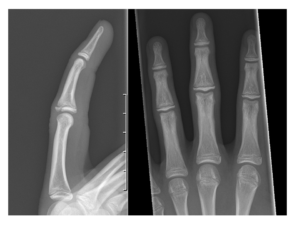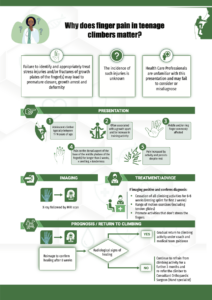Introduction
Climbing is a popular physical activity and Olympic sport. The intense training undertaken by adolescent climbers can result in the development of primary periphyseal stress injuries (PPSI) of the fingers. Such injuries need to be identified early and managed appropriately to facilitate a timely return to sport and prevent potentially serious negative consequences (1).
Climbing Activity
Competition sport climbing includes three separate formats:lead climbing, bouldering, and speed climbing. All formats place increased demands on the skeletally immature fingers of adolescent climbers, especially during their peak velocity growth phase. However, it is the nature of the repetitive mechanical loading that induces injury (2).
Pathophysiology
Repetitive mechanical load is considered to disrupt normal metaphyseal blood supply which affects the flow of blood supply and mineralisation of mature chondrocytes in the hypertrophic zone (3). If mechanical loading continues unabated, widening of the growth plate and fracture may occur. Continuation of climbing activity whilst in an injurious state prolongs the ischaemia, which can result in deformity (4).
Diagnosis
The clinical picture is of an adolescent climber with an insidious onset of focal pain on the dorsal aspect of the finger-typically middle and/or ring-approximate to the insertion of the central slip of the extensor tendon at the base of the middle phalanx (5). X-ray and magnetic resonance imaging are key to confirming diagnosis. X-rays may not always reveal a problem, so if a high index of suspicion remains, an MRI should be performed (5). A Salter-Harris type III fracture is the most common presentation seen on imaging (See Figure 1). Alternative diagnoses may be considered if a PPSI is ruled out; these include damage to the annular pulley system, collateral ligaments, extensor hood, accessory collateral ligaments and volar plate (5).

Figure 1: Plain X-ray Salter Harris type III fracture in an adolescent climber.
Management
Cessation of all climbing activity is advised for 6-8 weeks following diagnosis. Climbing specific rehabilitation should not commence until imaging confirms healing. Once healing is confirmed a conservative approach to rehabilitation is preferred, with the primary focus being a gradual return to climbing activities (5). ‘Grip blocks’ and ‘hang boards’ may be utilised to load the fingers in a progressive and controlled manner. However, the use of dynamic finger training apparatus such as campus boards should be discouraged until skeletal maturity of the fingers is attained (5). Aggravation of symptoms should be investigated, and rehabilitation immediately suspended. In rare cases epiphysiodesis, using a spot drilling technique, is considered necessary and successful outcomes are reported (5).

Authors:
Gareth Jones¹,7, Rowena Johnson 2, Volker Schöffl 3, 4,1, Isabelle Schöffl 5,1, Chris Lutter 6,1, Mark I. Johnson 7, Tim Halsey 8,1
1 School of Health, Leeds Beckett University, Leeds, UK
2 Carnegie School of Sport, Leeds Beckett University, Leeds, UK
3 Department of Orthopedic and Trauma Surgery, Klinikum Bamberg, Bamberg, Germany
4 Section of Wilderness Medicine, Department of Emergency Medicine, University of Colorado School of Medicine, USA
5 Department of Orthopedic and Trauma Surgery, Friedrich Alexander Universität Erlangen-Nürnberg, Erlangen, Germany
6 Department of Orthopedics, Rostock University Medical Center, Rostock, Germany
7 Centre for Pain Research, Leeds Beckett University, Leeds, UK
8 Department of Orthopedics, Rotherham Hospital, Rotherham, UK
Corresponding author
e-mail: g.j.jones@leedsbeckett.ac.uk
Gareth Jones, School of Health, Leeds Beckett University, City Campus, Leeds, LS1 3HE.
Orchid ID
Gareth Jones: 0000-0002-0313-0092
Volker Schöffl 0000-0002-3855-7934
Mark Johnson: 0000-0002-9421-9622
Timothy Halsey: 0000-0001-5938-4342
References
- Jones G, Schöffl V, Johnson MI. Incidence, Diagnosis, and Management of Injury in Sport Climbing and Bouldering: A Critical Review. Curr Sports Med Rep. 2018;17(11):396-401. Epub 2018/11/09. doi: 10.1249/jsr.0000000000000534. PubMed PMID: 30407948.
- Caine D, Meyers R, Nguyen J, Schöffl V, Maffulli N. Primary Periphyseal Stress Injuries in Young Athletes: A Systematic Review. Sports Med. 2022;52(4):741-72. Epub 2021/08/10. doi: 10.1007/s40279-021-01511-z. PubMed PMID: 34370212
- Bedoya MA, Jaramillo D, Chauvin NA. Overuse injuries in children. Top Magn Reson Imaging. 2015;24(2):67-81. Epub 2015/04/04. doi: 10.1097/rmr.0000000000000048. PubMed PMID: 25835584.
- El-Sheikh Y, Lutter C, Schoeffl I, Schoeffl V, Flohe S. Surgical Management of Proximal Interphalangeal Joint Repetitive Stress Epiphyseal Fracture Nonunion in Elite Sport Climbers. J Hand Surg Am. 2018;43(6):572.e1-.e5. Epub 2017/11/18. doi: 10.1016/j.jhsa.2017.10.009. PubMed PMID: 29146511.
- Jones, G., Johnson, R., Schöffl, V. et al (2022) Primary Periphyseal Stress Injuries of the Fingers in Adolescent Climbers: A Critical Review. Current Sports Medicine Reports, 1;21(12):436-442. doi: 10.1249/JSR.0000000000001016. PMID: 36508599.